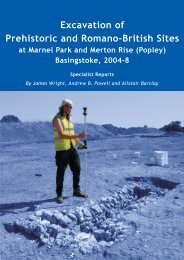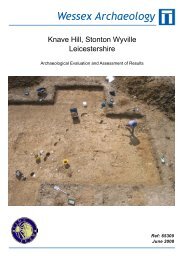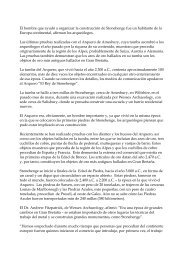Knave Hill, Stonton Wyville, Leicestershire - Wessex Archaeology
Knave Hill, Stonton Wyville, Leicestershire - Wessex Archaeology
Knave Hill, Stonton Wyville, Leicestershire - Wessex Archaeology
Create successful ePaper yourself
Turn your PDF publications into a flip-book with our unique Google optimized e-Paper software.
excavation had ceased all trenches were cleaned by hand and archaeologicaldeposits investigated.3.3.3 At various stages during excavation the deposits were scanned by a metaldetector and signals marked in order to facilitate investigation. Theexcavated up-cast was scanned by metal detector.3.3.4 All archaeological deposits were recorded using <strong>Wessex</strong> <strong>Archaeology</strong>’s proforma record sheets with a unique numbering system for individual contexts.Trenches were located using a Trimble Real Time Differential GPS surveysystem. All archaeological features and deposits were planned at a scale of1:20 with sections drawn at 1:10. All principal strata and features wererelated to the Ordnance Survey datum.3.3.5 A full photographic record of the investigations and individual features wasmaintained, utilising colour transparencies, black and white negatives (on35mm film) and digital images. The photographic record illustrated both thedetail and general context of the archaeology revealed and the Site as awhole.3.3.6 At the completion of the work, all trenches were reinstated using theexcavated soil.3.3.7 A unique Site code (KNA 07) was agreed prior to the commencement ofworks. The work was carried out on the 28 th July – 1 st August 2007. Thearchive and all artefacts were subsequently transported to the offices of<strong>Wessex</strong> <strong>Archaeology</strong> in Salisbury where they were processed and assessedfor this report.4 RESULTS4.1 Introduction4.1.1 Details of individual excavated contexts and features, the full geophysicalreport (GSB 2007), the summary of the landscape and earthwork survey anddetails of artefactual and environmental assessments, are retained in theproject archive. Summaries of the excavated sequences can be found inAppendix 1.4.2 Geophysical Survey4.2.1 Geophysical survey (Figure 2) using a magnetometer was carried out in twoareas, covering in total 2.56ha. All data and discussion that follows is takenfrom the report provided by GSB Prospection (2007). The recent harrowingof the field introduced an element of noise that may have masked weakeranomalies; this may introduce a bias against features of certain date, inparticular those of the Anglo-Saxon period.4.2.2 The main discovery of the magnetic survey was a D-shaped enclosure. Anumber of pits and ditches were also observed. Ridge and furrow cultivationresponses can be seen throughout the data.4





